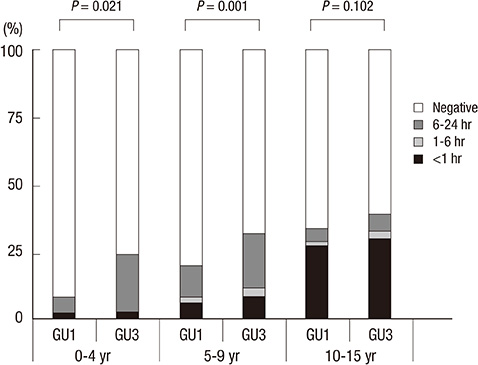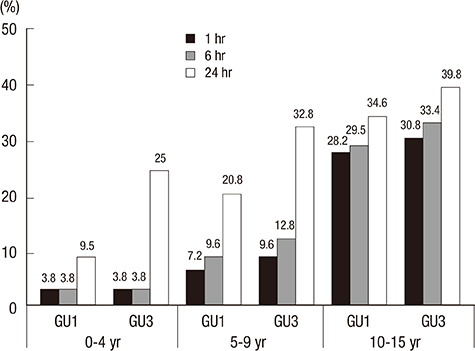J Korean Med Sci.
2014 Jan;29(1):106-109. 10.3346/jkms.2014.29.1.106.
Correlation between Positive Rate and Number of Biopsy Samples on Urease Test in Childhood Helicobacter pylori Infection
- Affiliations
-
- 1Department of Pediatrics, Gyeongsang National University School of Medicine, Gyeongsang Institute of Health Sciences, Jinju, Korea. hsyoun@gnu.ac.kr
- 2Department of Microbiology, Gyeongsang National University School of Medicine, Gyeongsang Institute of Health Sciences, Jinju, Korea.
- KMID: 1796922
- DOI: http://doi.org/10.3346/jkms.2014.29.1.106
Abstract
- To identify the correlation between the number of gastric biopsy samples and the positive rate, we compared the results of urease test using one and three biopsy samples from each 255 children who underwent gastroduodenoscopy at Gyeongsang National University Hospital. The children were divided into three age groups: 0-4, 5-9, and 10-15 yr. The gastric endoscopic biopsies were subjected to the urease test. That is, one and three gastric antral biopsy samples were collected from the same child. The results of urease test were classified into three grades: Grade 0 (no change), 1 (6-24 hr), 2 (1-6 hr), and 3 (<1 hr). The positive rate of urease test was increased by the age with no respect to the number of gastric biopsy samples (one biopsy P = 0.001, three biopsy P < 0.001). The positive rate of the urease test was higher on three biopsy samples as compared with one biopsy sample (P < 0.001). The difference between one and three biopsy samples was higher in the children aged 0-9 yr. Our results indicate that the urease test might be a more accurate diagnostic modality when it is performed on three or more biopsy samples in children.
MeSH Terms
Figure
Cited by 1 articles
-
Diagnosis of Helicobacter pylori Infection in Children and Adolescents in Korea
Ji-Hyun Seo, Ji-Sook Park, Kwang-Ho Rhee, Hee-Shang Youn
Pediatr Gastroenterol Hepatol Nutr. 2018;21(4):219-233. doi: 10.5223/pghn.2018.21.4.219.
Reference
-
1. Malaty HM, El-Kasabany A, Graham DY, Miller CC, Reddy SG, Srinivasan SR, Yamaoka Y, Berenson GS. Age at acquisition of Helicobacter pylori infection: a follow-up study from infancy to adulthood. Lancet. 2002; 359:931–935.2. Midolo P, Marshall BJ. Accurate diagnosis of Helicobacter pylori: urease tests. Gastroenterol Clin North Am. 2000; 29:871–878.3. Dondi E, Rapa A, Boldorini R, Fonio P, Zanetta S, Oderda G. High accuracy of noninvasive tests to diagnose Helicobacter pylori infection in very young children. J Pediatr. 2006; 149:817–821.4. Madani S, Rabah R, Tolia V. Diagnosis of Helicobacter pylori infection from antral biopsies in pediatric patients is urease test that reliable? Dig Dis Sci. 2000; 45:1233–1237.5. Elitsur Y, Hill I, Lichtman SN, Rosenberg AJ. Prospective comparison of rapid urease tests (PyloriTek, CLO test) for the diagnosis of Helicobacter pylori infection in symptomatic children: a pediatric multicenter study. Am J Gastroenterol. 1998; 93:217–219.6. Siddique I, Al-Mekhaizeem K, Alateegi N, Memon A, Hasan F. Diagnosis of Helicobacter pylori: improving the sensitivity of CLOtest by increasing the number of gastric antral biopsies. J Clin Gastroenterol. 2008; 42:356–360.7. Genta RM, Graham DY. Comparison of biopsy sites for the histopathologic diagnosis of Helicobacter pylori: a topographic study of H. pylori density and distribution. Gastrointest Endosc. 1994; 40:342–345.8. Lim LL, Ho KY, Ho B, Salto-Tellez M. Effect of biopsies on sensitivity and specificity of ultra-rapid urease test for detection of Helicobacter pylori infection: a prospective evaluation. World J Gastroenterol. 2004; 10:1907–1910.9. Vassallo J, Hale R, Ahluwalia NK. CLO vs histology: optimal numbers and site of gastric biopsies to diagnose Helicobacter pylori. Eur J Gastroenterol Hepatol. 2001; 13:387–390.10. Seo JH, Youn HS, Park JJ, Yeom JS, Park JS, Jun JS, Lim JY, Park CH, Woo HO, Ko GH, et al. Influencing factors to results of the urease test: age, sampling site, histopathologic findings, and density of Helicobacter pylori. Pediatr Gastroenterol Hepatol Nutr. 2013; 16:34–40.11. Carelli AP, Patrício FR, Kawakami E. Carditis is related to Helicobacter pylori infection in dyspeptic children and adolescents. Dig Liver Dis. 2007; 39:117–121.12. Drumm B. Helicobacter pylori in the pediatric patient. Gastroenterol Clin North Am. 1993; 22:169–182.13. Laine L, Lewin DN, Naritoku W, Cohen H. Prospective comparison of H&E, Giemsa, and Genta stains for the diagnosis of Helicobacter pylori. Gastrointest Endosc. 1997; 45:463–467.14. Tang JH, Liu NJ, Cheng HT, Lee CS, Chu YY, Sung KF, Lin CH, Tsou YK, Lien JM, Cheng CL. Endoscopic diagnosis of Helicobacter pylori infection by rapid urease test in bleeding peptic ulcers: a prospective case-control study. J Clin Gastroenterol. 2009; 43:133–139.15. Gisbert JP, Abraira V. Accuracy of Helicobacter pylori diagnostic tests in patients with bleeding peptic ulcer: a systematic review and meta-analysis. Am J Gastroenterol. 2006; 101:848–863.16. Engstrand L, Rosberg K, Hübinette R, Berglindh T, Rolfsen W, Gustavsson S. Topographic mapping of Helicobacter pylori colonization in long-term-infected pigs. Infect Immun. 1992; 60:653–656.
- Full Text Links
- Actions
-
Cited
- CITED
-
- Close
- Share
- Similar articles
-
- The Diagnosis of Helicobacter pylori Infection
- Serologic Diagnosis of Helicobacter pylori Gastritis in Children : Seroepidemiology of H. pylori in Normal School Children and Diagnostic Accuracy of IgG GAP Test in Children with Gastrointestinal Symptoms
- Purification of the urease of helicobacter pylori and production of monoclonal antibody to the urease of helicobacter pylori
- The Role of Direct Polymerase Chain Reaction in the Dection of Helicobacter pylori Infections
- Evaluation of Urea Breath Test for the Detection of Helicobacter pylori Infection



